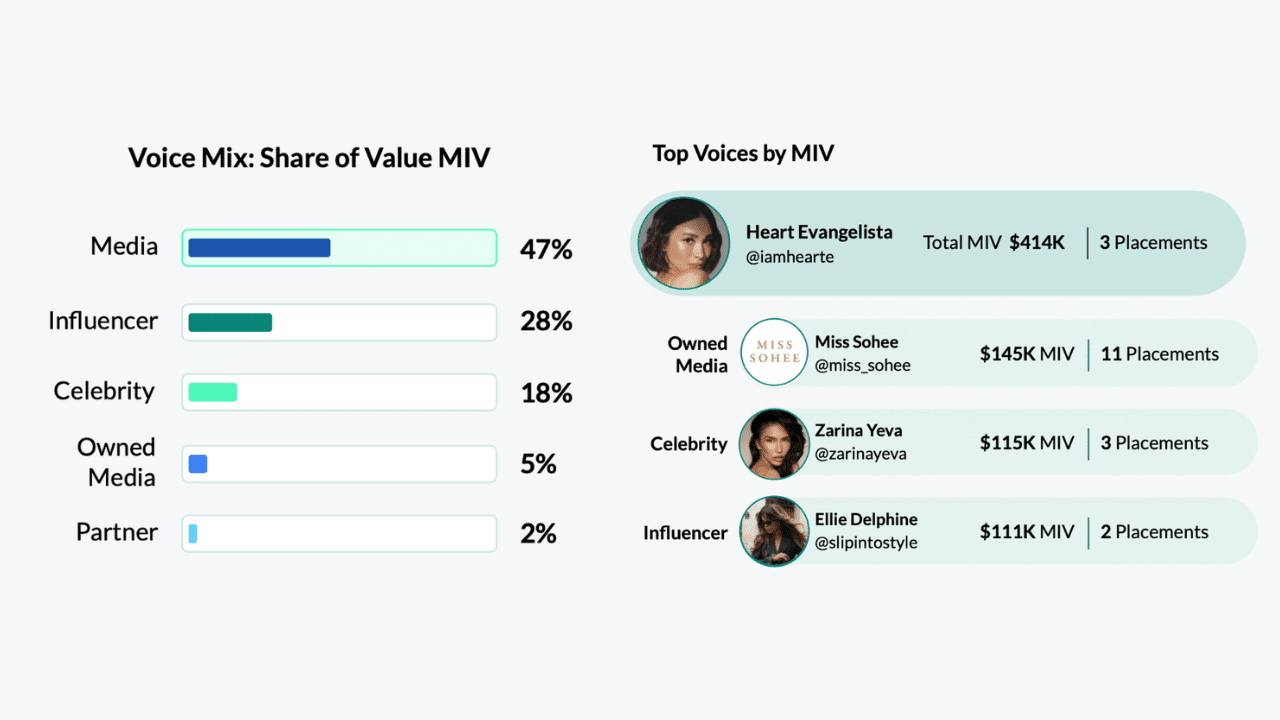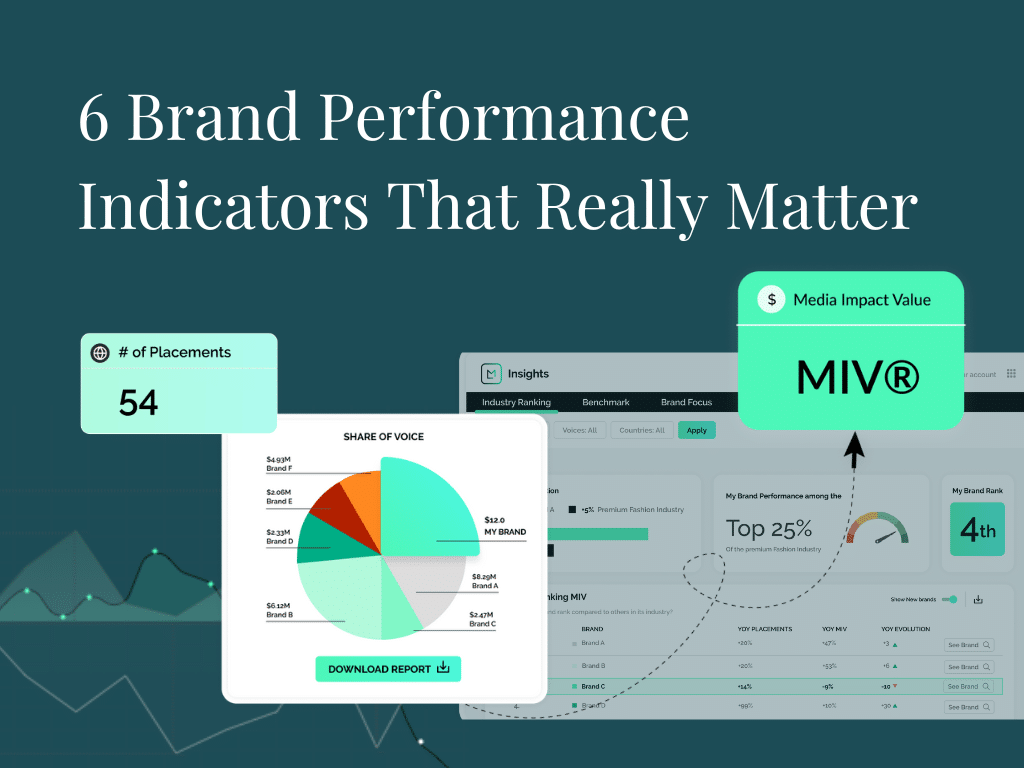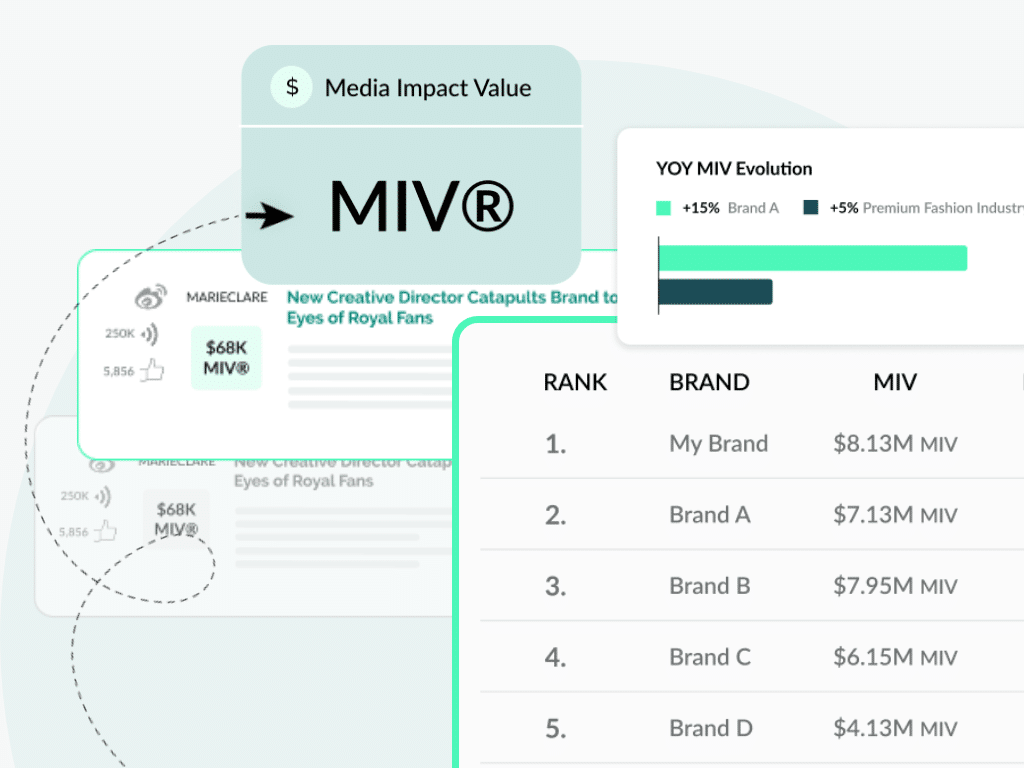Success today isn’t just about how much you sell—it’s about how your brand is seen and the perceived value. That’s why understanding your brand performance is more important than ever. To stay competitive, you need to measure the intangible: how people feel about your brand, the value they associate with it and the impact it makes across every channel. That’s where brand performance indicators come into play.
Yet, as we all know, measuring brand performance isn't easy. It involves getting a complete picture of your brand image, taking into account everything from media coverage and influencer mentions to consumer sentiment and cultural relevance. These are complex, fragmented signals that are difficult to quantify with traditional tools.
At Launchmetrics, we developed Media Impact Value® (MIV®), a proprietary algorithm that assigns a monetary value to brand exposure across print, online and social media. While it’s a powerful benchmark, we know that no single metric can tell the full story. Brand performance must be understood within a much broader framework of analysis, and through a methodology adapted to the specificities of the Fashion, Lifestyle and Beauty (FLB) industries.
In this article, we’ll walk you through the five essential brand performance indicators you should be tracking—and show you how to make sense of them within a comprehensive measurement framework.
In this article you’ll learn…
What Are Brand Performance Indicators?
Brand performance indicators are the key metrics used to evaluate how your brand is perceived and performing across various channels. Unlike sales or click-through rates, these indicators go beyond transactional data to assess the intangible: how your brand resonates with audiences, how visible it is and what kind of impact it's making in the market.
They reflect the strength of your brand image and its influence over time. From media coverage and influencer collaborations to customer sentiment and engagement, brand performance indicators help you measure what truly drives brand value.
In the next section, we’ll break down the five most essential brand performance indicators and show you how to use them to build a smarter, more data-driven strategy.
6 Key Brand Performance Indicators You Should Be Tracking
To truly measure how your brand is performing—not just in visibility, but in influence and impact—you need to go beyond surface-level stats. These five brand performance indicators act as essential brand marketing metrics, giving you a more complete view of your brand’s value.
1. Voices
Your brand is shaped by more than just your own messaging. Media, Influencers, Celebrities, Partners and your Owned Media channels make up the five distinct Voices that contribute to your overall marketing performance. By analyzing the impact of these Voices, you gain insight into which activities drive the most value across the customer buying journey, from awareness and consideration to conversion and retention.
2. Media Impact Value (MIV)
Launchmetrics’ proprietary machine learning algorithm, MIV, assigns a monetary value to every post, interaction and article. This allows brands to measure the impact of all marketing activities across Voices, channels and markets in a unified way. Finely tuned to the specificities of Fashion, Lifestyle and Beauty (FLB), the algorithm analyzes more than 100 quantitative and qualitative attributes including reach, industry relevance, source authority and content quality. It goes beyond basic impressions or engagement to provide a deeper understanding of brand visibility and performance. As a result, MIV serves as a powerful benchmark for evaluating brand value and campaign ROI.
3. Share of Value
This indicator shows the percentage of overall MIV generated by a brand, segment or influencer during a specific time period (e.g., monthly) or event (e.g., fashion week, BeautyCon or Baselworld). It helps you understand how much of the total conversation your brand owns and allows you to benchmark your marketing and communications strategy against competitors.
4. Share of Voice
Share of Voice is similar to Share of Value, but focuses on the volume of brand mentions rather than the monetary value. Share of Voice can be used to identify the most talked-about brand during a campaign or event. It’s also a valuable tool for benchmarking visibility and refining communication strategies in real time.
5. Placements
Placements refers to the number of posts, interactions or articles related to a specific topic, brand or product. This metric helps you understand the volume of conversation generated through the unit count of your brand mentions. As a foundational element of marketing performance measurement, this metric helps you track how often your brand is appearing across key media channels, offering insight into visibility, consistency and campaign reach over time.
6. Voice Echo
Voice Echo measures both the direct and indirect impact of a marketing activity. Say you run a campaign with a brand ambassador: as well as the value of the content they create, there’s also the ripple effect of media coverage about the partnership and other Voices discussing it. By measuring how content is amplified, brands can see beyond immediate results to assess the broader impact of any campaign or activity. This indicator also supports competitive benchmarking and helps estimate potential ROI before investing in new celebrity or influencer partnerships.
Brand Performance Indicators vs Brand Awareness
While brand awareness is an important part of any marketing strategy, it’s only one piece of the puzzle. It tells you how many people recognize or recall your brand, but it doesn’t show how your brand is perceived, what kind of impact it's making or whether that awareness is driving meaningful engagement.
That’s where brand performance indicators come in. They go beyond visibility to measure the quality, value and effectiveness of your brand’s presence across channels. For example, two brands might have similar awareness levels, but one could be generating higher-value media placements, stronger influencer engagement or more impactful messaging—key differences that brand awareness alone won’t reveal.
In other words, brand awareness tells you if people know about you. Brand performance indicators tell you how well your brand is actually performing in the market, and what kind of ROI you're getting from that attention.
Understanding the relationship between these two concepts helps you move from surface-level success to a strategy that’s grounded in deeper brand impact.
Why Brand Performance Indicators Matter in Marketing Performance Measurement
Traditional marketing performance measurement often focuses on hard metrics like conversions, click-through rates or return on ad spend. While these are essential for evaluating the short-term effectiveness of campaigns, they don’t fully capture the long-term equity your brand is building.
Brand performance indicators help you assess the strength of your brand across earned, owned and paid media, providing a more holistic view of how your brand is performing in the real world.
Take the case of a brand launching a collection during fashion week. Using the example of Miss Sohee from our SS25 Haute Couture data report, we can see that the brand garnered $3M in MIV from 578 placements. These two indicators allow us to determine a third one: average MIV per placement. Though Miss Sohee’s overall MIV was much lower than a major brand like Chanel (whose show brought them $51.1M in MIV), their average MIV per placement was almost on par ($5.2K to Chanel’s $5.5K), showing that the brand excelled at maximizing the value of each placement.
We can also use the Share of Value indicator to analyze which Voices drove the most impact. For Miss Sohee, Media accounted for 47% of total MIV, followed by Influencers (28%), Celebrities (18%), Owned Media (5%) and Partners (2%). This is a valuable insight for future campaigns, and one that can be tied back to the specific accounts and publications to determine the most lucrative relationships.

Source: Launchmetrics' Men's Fashion Week & Haute Couture Week 2025 Report
By combining both brand and marketing performance metrics, you get a more complete understanding of what's driving success. This is especially important for FLB brands, where emotional connection, cultural relevance and perception are just as important as conversion rates.
How to Use Brand Performance Indicators to Optimize Your Marketing Strategy
Now you know what to track. It’s time to take a look at how to use these brand performance indicators to optimize campaigns and drive long-term brand equity. Here’s how you can put these metrics into action:
- Benchmark performance regularly
Track MIV, Share of Voice and Placements across each campaign, season or key event. Use these benchmarks to compare against past performance or industry competitors. - Refine your Voice mix
Analyze which Voices (Media, Influencer, Celebrity, Partner or Owned Media) are delivering the highest value. Double down on what’s working and reallocate resources where needed. - Identify high-impact partners
Look beyond total MIV to pinpoint who consistently generates strong value per placement. These are the partners you want to nurture for long-term brand amplification. - Inform creative and content strategy
If certain types of coverage, formats or storytelling angles generate higher MIV, use those insights to refine your messaging and visual direction across channels. - Connect metrics to business outcomes
Align your brand and performance marketing efforts. When brand equity indicators are aligned with ROI goals, you can justify creative investments and better forecast long-term value.
Bring It All Together With a Unified Dashboard
Tracking each of these metrics in isolation is a start, but it can lead to a fragmented view of performance. What sets winning brands apart isn’t just access to data, but a well-structured measurement framework that aligns your strategy, KPIs and indicators. When visualized together, these metrics offer a clear, actionable picture of how your brand is performing—and where to go next. It’s this unified view that enables faster, smarter decision-making.
That’s why it’s essential to bring them together in a centralized, structured dashboard. While you can piece things together using a custom-built tool in Data Studio or Excel, a brand performance platform like Launchmetrics puts everything directly at your fingertips. Our dashboards are purpose-built for the FLB industries, enabling you to easily visualize all the key performance indicators in one place.
Whether you’re monitoring PR mentions or benchmarking against competitors, our dashboard filters allow you to cut through the noise and break down data by channel, Voice, region and more. Wth customizable views and bespoke reports, you can also tailor insights for different teams and stakeholders. This makes it easier to showcase your success and turn data into actionable insights for better collaboration.
As Avinash Kaushik, one of the biggest experts on measurement issues, explains in his blog, "There is a difference between winners and losers when it comes to analysis. Winners, long before they think about data or tools, have a well-structured model or measurement framework. Losers do not.”
That’s why, rather than getting lost in the granular details—like likes, engagements or reach—it’s far more valuable to have a data visualization framework that helps you clearly interpret those figures and make informed strategic decisions.

Source: Launchmetrics' Insights dashboard visualizing the MIV evolution for a brand
Measuring your brand performance with the right tools helps you to evaluate how your brand is positioned in the market and how it stacks up against competitors. It not only reveals how your strategy is evolving over time—e.g., month to month or quarter to quarter—but also shows how effectively your brand image is resonating with consumers. Are you attracting attention, retaining interest and building loyalty at each stage of the customer journey? These are the insights brand performance indicators can uncover.
Guide to Understanding Media Impact value (MIV)
Want to dive deeper into MIV, how it works and how to use it to measure the true impact of your marketing activities? Download our Guide to Understanding MIV, which explores how MIV compares to traditional metrics and how FLB brands are using it across different verticals.

